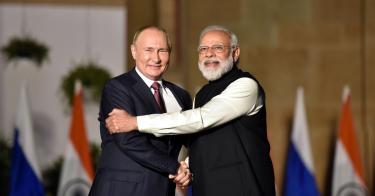On Dec. 6, Russian President Vladimir Putin, joined by his foreign and defense ministers, arrived in India for a summit with Indian Prime Minister Narendra Modi. India and Russia have a defense relationship stretching back to the Cold War, and leader-level summits are a common affair. Yet, the timing of the meeting was unfortunate, coming just as the U.S. and several European capitals are sounding the alarm bell over Russian preparation for what could be a major military offensive into Ukraine.
Further, Modi’s meeting with Russia’s autocratic leader came just days before the Indian prime minister represented the world’s largest democracy at U.S. President Joe Biden’s Summit for Democracy. Finally, the India-Russia summit landed at a sensitive time in the burgeoning India-U.S. strategic partnership. The Biden administration may soon have to decide whether to impose sanctions on India for its purchase of the Russian S-400 air defense system.
The Countering America’s Adversaries Through Sanctions Act, or CAATSA, was passed by Congress in the wake of complaints about Russia interference in the 2016 U.S. presidential election. The Act requires the U.S. president to impose sanctions on foreign entities engaged in significant transactions with Russia’s defense and intelligence sectors. Although the India-Russia S-400 agreement predates the passage of CAATSA, India still risks sanctions.
If the timing and optics of the Russia-India summit are problematic for the U.S., the dearth of substantial takeaways showed the limits of the once-robust India-Russia partnership. The summit produced a list of 28 agreements that was conspicuously thin on content. Aside from an extension of their military-technical cooperation framework, the vast majority of agreements signed were relatively low-level Memorandums of Understanding between various research institutes, sports associations, and cultural festivals.
>>> The Future of the Quad Is Bright
Although Russia has been India’s top defense supplier for most of the past half-century, the only notable defense deal announced during Putin’s trip was an arrangement to produce Kalashnikov assault rifles in India. Meanwhile, an expected logistics exchange agreement, like the one India signed with the U.S. in 2016, was reportedly “put off for some time.”
At the summit, India and Russia announced their intention to reach $30 billion in bilateral trade by 2025, up from just $8 billion in 2020. Contrast that with the $122 billion in India-U.S. trade in 2020, a pandemic-related dip from the record-breaking $146 billion in bilateral trade in 2019. As if to further underscore the disparity, shortly after the India-Russia summit the U.S. International Development Finance Corporation announced a $500 million loan to First Solar Inc. to build a solar panel factory in India’s Tamil Nadu state, marking one of the largest loans ever issued by the relatively new development agency.
The Putin-Modi summit also served to underscore some of the expanding geopolitical differences between Moscow and New Delhi. Russian Foreign Minister Sergei Lavrov took the opportunity to criticize the U.S., noting: “We expressed our serious concern to our Indian friends over the U.S. activity there under the slogan of so-called Indo-Pacific strategies and the creation of closed bloc-type structures.”
Despite the Modi government’s embrace of the Indo-Pacific, Russian officials have repeatedly criticized the concept in New Delhi. Lavrov previously said the West was "trying to engage India in anti-China games by promoting Indo-Pacific strategies." He also attacked the Indo-Pacific concept as “divisive” and designed “to exclude China,” insisting: “Our Indians friends are smart enough to understand that.”
However, India is all-in on the Indo-Pacific. Last year, Indian External Affairs Minister Jaishankar explained that it was a “matter of satisfaction that the Indo-Pacific concept has gained increasingly wider acceptance.”
Meanwhile, Lavrov’s criticism of “closed bloc-type structures” represented an attack on the Quad grouping of Indo-Pacific democracies India has joined with Australia, Japan, and the U.S. The Russian ambassador to India previously warned the Quad would be “detrimental to the inclusive dialogue in the region.” Russian officials have insisted India instead embrace Russian- and Chinese-led exclusive dialogues like the Shanghai Cooperation Organization, BRICS, and the Russia-India-China trilateral dialogue. Many in New Delhi grumble that those organizations remain largely paralyzed by differences among their members states.
Even as Russia complained about two pro-U.S. initiatives the Modi government has endorsed, it had nothing critical to say about China or the unprecedented crisis at the China-India border in 2020—one that resulted in the first casualties from border hostilities in over 40 years. By contrast, the U.S. has repeatedly condemned China’s actions and rushed drones and special cold weather equipment to the Indian military as the crisis was unfolding.
Russia’s tightening strategic embrace of China, at a time China-India ties have plunged to new lows amid a deadly border crisis, has further tested an India-Russia relationship already diminished from its Cold War heights. In a reversal from the late Cold War, Russia now sells some its most advanced military hardware to China before India, including the S-400 system. Moscow and Beijing are also conducting a growing number of sophisticated military exercises and synergizing their diplomatic statements and threat assessments.
While the long-term trends are clear, after a half century of intimate defense cooperation Russia will remain an important security and diplomatic partner of India’s for the foreseeable future. Even as New Delhi has diversified its defense suppliers in recent years—with major purchases of U.S., European, and Israeli hardware—the Indian military still remains heavily dependent on Russia to maintain its legacy military platforms. Russia is also the only country willing to offer India nuclear submarine technology, while Pentagon officials admit they did not have a direct alternative to the S-400 to offer India.
These realities cannot be willed away by the U.S. government despite its justifiable frustration with Moscow. Just as India has gradually come to accept the tens of billions of dollars of arms and aid the U.S. has provided rival Pakistan isn’t designed to disadvantage India, America can acknowledge the historical and pragmatic underpinnings of the Russia-India relationship.
>>> An Agenda for the 2021 Quad Summit: Five Next Steps
America must also be clear-eyed about her own national interest. India is a vital strategic partner for the U.S. in the Indo-Pacific and, as I outlined in a Heritage Fact Sheet earlier this year, it meets the specific legislative conditions required for an executive waiver from CAATSA sanctions. Indeed, years after CAATSA’s passage, Congress expanded the executive waiver authority specifically with India in mind.
More recently, Senators Ted Cruz, and Tod Young introduced a bill, the CRUCIAL Act, that would effectively make India and other members of the Quad exempt from CAATSA sanctions. U.S. officials recognize that sanctioning India under CAATSA is unlikely to alter India-Russia defense trade; liable to stoke Indian fears about American reliability and to provide ammunition to America’s critics in New Delhi; and provide Putin a victory. The Russian government welcomes every opportunity to exploit divisions in India-U.S. relations and highlight how, unlike Russia, the U.S. infringes on India’s strategic autonomy.
The shifting landscape of the Indo-Pacific suggests the yawning gap between Russia’s and India’s threat perceptions and geopolitical outlooks is likely to grow wider in the years ahead. America can nurture this transition by presenting itself as a more reliable and effective strategic alternative to Russia, drawing India closer to the Quad and its vision for the Indo-Pacific. Or it can double down on a vain effort to limit Russian defense exports, sowing discord in India-U.S. ties and providing President Putin an early Christmas gift.
This piece originally appeared in RealClear World




